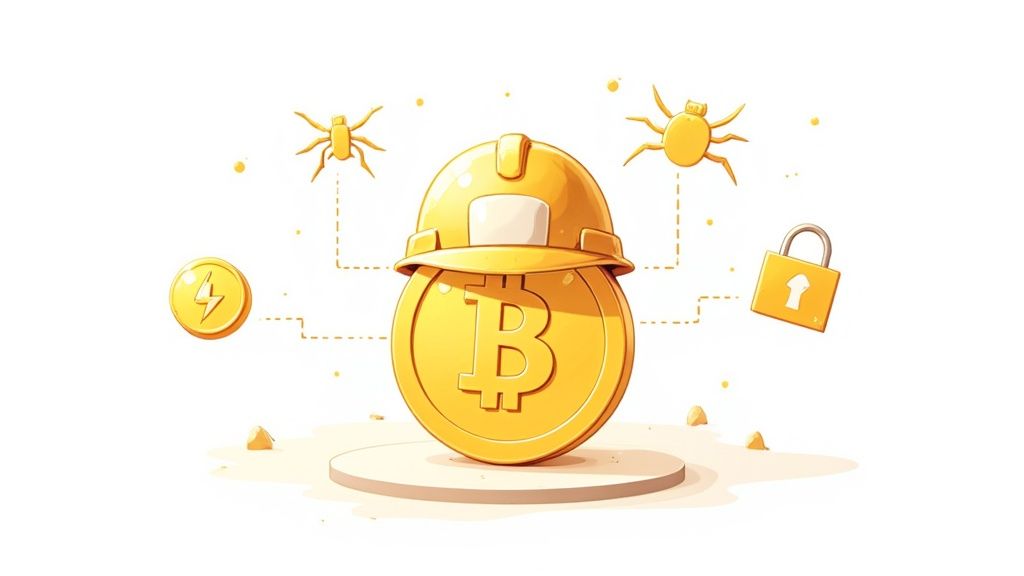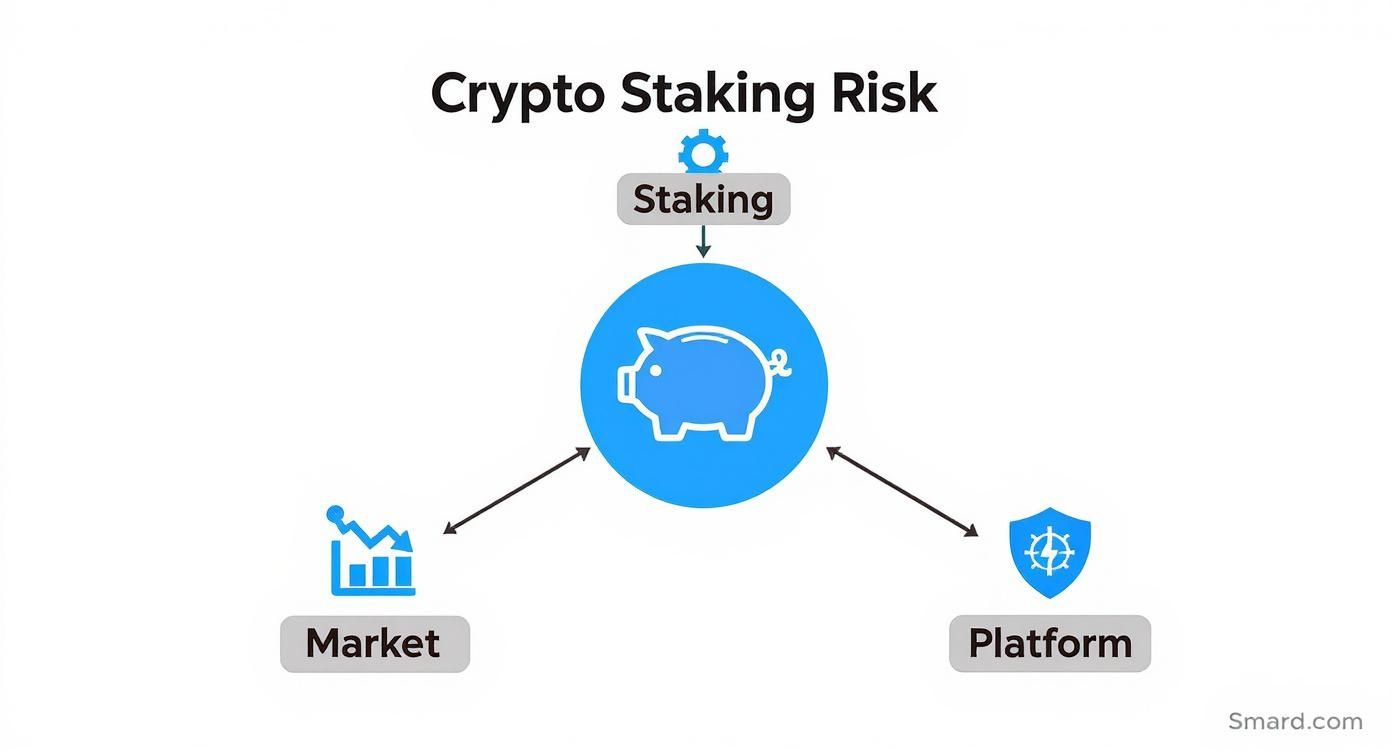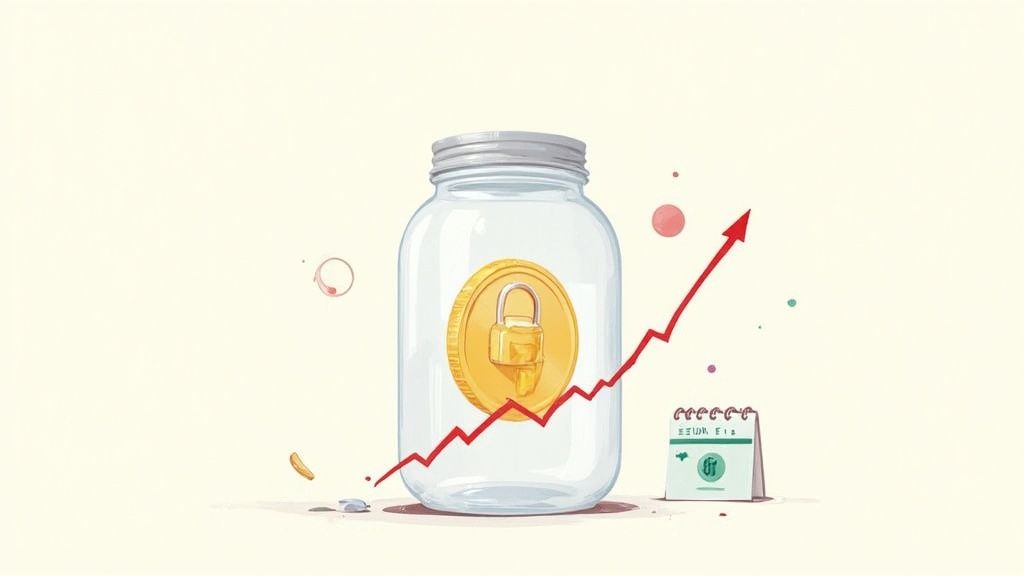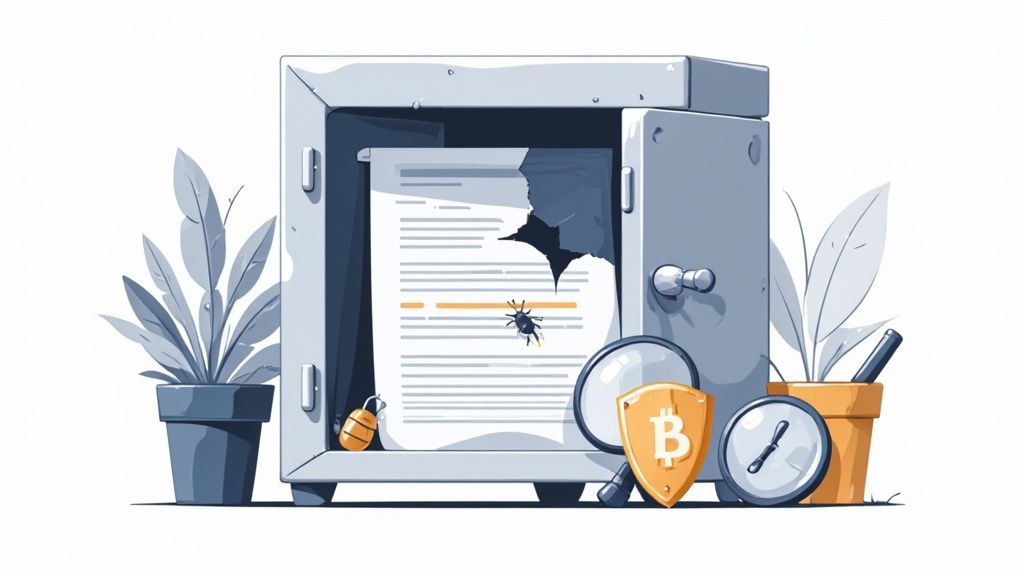Crypto Staking Risk Unpacked A Guide to Secure Staking

Let's be honest, crypto staking sounds incredible on the surface. You lock up your coins, help secure a network, and get paid for it—almost like a souped-up savings account for your digital assets. But anyone who’s been in this space for a while knows there’s no such thing as a free lunch. Every reward carries a crypto staking risk, and these aren't just little hiccups; we're talking about everything from market nosedives to technical glitches that can eat into your original investment.
An Honest Look at Staking Your Crypto
Those flashy Annual Percentage Yields (APYs) you see advertised are just one side of the story. Beneath that shiny exterior is a minefield of potential problems that can trip up even the most experienced crypto folks. Staking isn't "free money." It’s an active commitment where you're putting your capital on the line to support a blockchain, and with that comes real-world vulnerabilities.
This guide is here to give you the straight scoop on crypto staking risks. We'll skip the overly technical jargon and get right to the point, breaking down what can go wrong so you can learn to stake smarter.
The image below gives you a bird's-eye view of the main risk categories—market, technical, and platform-related—and how they all connect.

As you can see, these risks often overlap, meaning your staked assets can be hit from multiple directions at once.
The Core Risks at a Glance
Before we get into the nitty-gritty, let's quickly cover the main types of trouble you might run into. Think of it like a pilot's pre-flight check—you need to know what kind of turbulence to expect. Each of these risks requires a different game plan.
Here's a quick look at the major risk categories we'll be exploring.
A Quick Look at Major Staking Risks
This table breaks down the primary risks you'll encounter in crypto staking, what they mean in simple terms, and how they could affect your investment.
| Risk Category | What It Means in Simple Terms | How It Impacts Your Staked Assets |
|---|---|---|
| Market Volatility | The price of your crypto could crash while it's locked up, and you can't sell to cut your losses. | You might end up with less money in dollar terms than you started with, even after earning rewards. |
| Validator Slashing | The validator you've delegated your coins to messes up or goes offline, and the network penalizes them. | A portion of your (and their) staked assets gets "slashed," or permanently destroyed, as a penalty. |
| Smart Contract Bugs | Hackers find a flaw in the code of the staking platform or protocol and exploit it to steal funds. | You could lose all of your staked assets in a single exploit with little to no chance of recovery. |
| Liquidity Constraints | Your funds are locked for a set period, or the "liquid staking" token you receive loses its value. | You can't access your funds during an emergency, or your derivative token de-pegs, causing a loss. |
By getting a handle on these different risk types, you can start making more informed decisions. The goal isn't to completely eliminate risk—that's impossible in crypto—but to understand it, manage it, and stake with your eyes wide open.
Now, let's dive into each of these challenges one by one.
Navigating Market Volatility and Lockup Periods

Let's talk about one of the most common—and frankly, stomach-churning—risks in crypto staking: market volatility.
Imagine this. You’ve just staked a good chunk of your crypto, feeling great about the rewards you’re about to earn. Then, out of nowhere, the market tanks. Your first instinct is to cut your losses and sell, but you can't. Your funds are locked up tight.
This is the cold, hard reality of staking lockup periods. Many protocols make you commit your crypto for a specific amount of time, leaving you powerless to react when prices are in freefall. It’s like having your cash tied up in a GIC while watching a stock market crash from the sidelines—you're just a spectator to your portfolio’s shrinking value. Any rewards you might have earned can get wiped out in a flash.
The Dangers of Unbonding Periods
Even if there isn't a strict lockup, most Proof-of-Stake networks have what’s called an “unbonding” or “cooldown” period. So when you decide you want your coins back, you have to wait. This waiting game can last anywhere from a few days to several weeks.
During this time, you're in a tough spot. Your assets aren't earning you any more rewards, but you can't sell or move them either. You’re completely exposed to whatever the market does next, with no way to protect yourself. This detail often catches new stakers completely off guard.
A joint report from the European Banking Authority and ESMA pointed this out directly, flagging that wild price swings during lock-up periods are a major market risk for stakers. When you can’t get out of your position during a steep downturn, you’re basically forced to absorb massive, unavoidable losses.
This is why it's so important to have a handle on market dynamics before you lock anything up. If you can understand key market indicators and chart patterns, you'll be able to make much smarter decisions about when—and if—to stake.
Liquid Staking Tokens and De-Pegging Risk
Liquid staking has become a popular way to get around these lockups. The idea is simple: you stake your asset (like ETH) and get a tradable token back (like stETH) that you can use elsewhere in DeFi. It sounds perfect, right?
Well, it introduces a whole new kind of risk: de-pegging.
In theory, your liquid staking token (LST) should always be worth the same as the underlying asset it represents—a 1:1 ratio. But when the market gets really chaotic, that "peg" can break.
For instance, imagine a massive panic where everyone tries to sell their stETH for regular ETH all at once. The sudden rush of sellers can push the price of stETH way below the price of ETH. If you're forced to sell during one of these events, you end up taking a direct loss on your original investment.
This isn't just a hypothetical problem; it has happened before. It creates a wave of panic, forcing people to sell at a discount just to get their liquidity back. At the end of the day, whether you're dealing with traditional lockups or liquid staking, you're still exposed to market forces that are completely out of your control.
How Validator Slip-Ups Can Cost You: A Look at Slashing Risk

When you delegate your crypto, you’re not just sitting back and collecting rewards. You’re putting your trust in a validator to do their job right. Think of them as the network's trusted bookkeepers, responsible for honestly processing transactions and keeping everything humming along. But what happens if one of them messes up or, even worse, tries to cheat?
This is where one of the most direct risks in crypto staking rears its head: slashing.
Slashing is basically an automated fine the network hits a validator with when it misbehaves. If a validator messes up, a chunk of their staked crypto—and by extension, yours—is permanently zapped as a penalty. It’s the network’s built-in enforcement mechanism to keep everyone in line and ensure only the good actors get to validate transactions.
What Gets a Validator in Trouble?
Slashing doesn’t happen out of the blue. It’s triggered by specific actions that put the blockchain's integrity at risk. The exact rulebook changes from network to network, but the big no-nos usually fall into a couple of buckets.
Going Offline (Liveness Faults): This is the most common reason for a slap on the wrist. If a validator's server crashes or goes offline for too long, they can't do their job. The network sees this as being unreliable and will often issue a small penalty, which is usually less severe than a full-blown slash.
Cheating the System (Double Signing): This is the cardinal sin. It happens when a validator tries to approve two different versions of the blockchain at the same time, essentially attempting to rewrite history. This is a direct attack on the network’s trustworthiness and always leads to a hefty slash.
The financial hit from these mistakes can be serious. Validator slashing is a very real risk, and it means a validator’s poor performance can directly eat into your initial investment.
Take Ethereum, for example. In a recent year, the network's slashing rate was around 0.15% of all staked ETH. That might sound small, but it added up to roughly 5,000 ETH getting slashed in just the first six months. These penalties are passed right down to the stakers who delegated to those validators, which really drives home how important it is to pick a good one.
Due Diligence Is Your Best Defense
Since you’re handing your assets over to a third party, the responsibility falls on you to pick a reliable partner. Before you delegate a single coin, you need to do your homework and vet potential validators. How they've performed in the past is often the best clue to how they'll perform in the future.
Choosing a validator with a solid track record is a must. Look for key stats like high uptime (you want to see 99%+) and a clean history with zero slashing events. Pay attention to their commission fees, too—make sure they're reasonable. It's also a great idea to see how active and helpful they are in their community. Digging into these details gives you a much better sense of their operational security. Learning how to assess a reputation score can give you a solid framework for judging who you can trust.
At the end of the day, one of the smartest things you can do is spread your stake across a few different validators. Don't put all your eggs in one basket. That way, if one validator gets into trouble, the damage to your overall portfolio is contained.
The Hidden Risk DeFi Stakers Often Overlook: Impermanent Loss
When you first dip your toes into DeFi, you'll see liquidity pools dangling some truly eye-popping APYs. But before you dive in, you need to know about a sneaky, often misunderstood risk called impermanent loss. It's a quiet portfolio-killer that can chip away at your gains, even when it looks like your tokens are soaring in value.
Think of it like trying to keep a see-saw perfectly balanced. On one end, you have ETH, and on the other, a stablecoin. As people trade, the protocol—the automated market maker (AMM)—is constantly shifting the weights to keep things level. The problem is, this constant rebalancing can leave you holding a mix of assets that’s worth less than what you started with.
Impermanent loss kicks in the moment the price ratio between the two tokens you've pooled together changes. If you pulled your money out right then, the total value would be lower than if you had just kept those same two tokens sitting in your wallet. It's called "impermanent" because the loss only locks in if you withdraw while the prices are out of whack.
How It Quietly Drains Your Staked Funds
Let's walk through a quick example. Say you deposit $500 worth of ETH and $500 of USDC into a liquidity pool. Your total stake is $1,000, and you start earning trading fees, which is great.
Now, imagine the price of ETH doubles. Awesome, right? Well, for your staked position, it's a mixed bag. To keep its internal see-saw balanced, the AMM protocol sells off some of your now more-valuable ETH for the less-valuable USDC.
If you decided to withdraw at that point, you’d get back less ETH and more USDC than you put in. Sure, your total position might be worth more than your initial $1,000, but here's the kicker: it will be worth less than if you had just held onto your original ETH and USDC from the start. That gap is your impermanent loss.
This isn't just a small-time headache; it's a major reason why many DeFi users lose money. Research shows that for liquidity providers on big-name platforms like Uniswap and Curve, the average impermanent loss can run between 8-12% a year. You can dive deeper into these kinds of DeFi staking risks and their impact on Webisoft.
Why Volatility is Your Worst Enemy
At its core, impermanent loss is all about volatility. The more the prices of your two tokens swing against each other, the bigger your potential loss becomes.
This is exactly why providing liquidity for a pair of two highly volatile assets is like playing with fire. On the flip side, pairs that include stablecoins (like DAI/USDC) are far less risky because their prices barely move. Those crazy-high APYs you see on volatile pairs are there for a reason—they're trying to make up for this exact risk. But sometimes, even the juiciest rewards can't offset the damage from impermanent loss.
Guarding Against Bugs in Smart Contracts and Platforms

Every single staking platform, DeFi protocol, and crypto wallet is just code. That simple fact opens the door to a massive crypto staking risk that most people ignore until it's way too late: bugs in the smart contracts. It doesn't matter how slick the website looks or how juicy the APY is—a single flaw in the code can wipe out everything.
Imagine a smart contract is like a digital vault with a high-tech, program-driven lock. If a clever hacker finds one tiny mistake in that program, they can pop the lock and empty the entire thing. This isn't just a "what if" scenario. The history of crypto is a graveyard of projects that lost millions of dollars overnight because of a single, undiscovered exploit.
These risks aren't just about sophisticated hacks, either. They can range from complex exploits to straight-up scams. A bad actor might use something called a "reentrancy bug" to trick a contract into paying them over and over again, or the entire project could just be a "rug pull"—a scam designed from day one to run off with everyone's money.
Why Security Audits Are Not Optional
This is precisely why you hear so much about security audits. They're non-negotiable. Before you even think about putting your crypto into a platform, your first step should be to check if it's been thoroughly vetted by reputable, independent auditors. Think of it like a home inspection for code. These experts poke and prod every line, trying to find cracks before a burglar does.
But here’s the thing: not all audits are the same. A quick once-over from some unknown firm doesn't cut it. You want to see platforms that have gone through multiple, tough audits from the big, respected names in the security world. It shows they're actually serious about keeping your funds safe.
Here's a critical point to remember: an audit isn't a lifetime immunity card. It's a snapshot in time. The moment a protocol updates its code, new holes can appear. This means security has to be an ongoing process, not a one-and-done checkbox.
Spotting the Red Flags to Protect Yourself
Beyond just looking for audit reports, you need to train yourself to spot the red flags that scream "high risk." A little bit of homework on a platform's history and documentation can save you a world of pain.
Keep an eye out for these tell-tale signs:
- Anonymous Teams: If the founders and developers are hiding behind pseudonyms, be very, very careful. When things go wrong, you want to know who is accountable.
- Vague Documentation: A whitepaper filled with fluffy marketing buzzwords instead of real technical details is a huge red flag. If they can't explain it clearly, they might not understand it themselves—or they might be hiding something.
- No Public Audits: This one's simple. If a staking protocol hasn't published its security audit reports for anyone to see, don't even think about using it.
For those who really want to get their hands dirty, you can even learn how to verify contract interaction logs yourself. This lets you see exactly what the smart contract is doing on the blockchain. At the end of the day, your best defense against this kind of devastating risk is to stick with platforms that are transparent and obsessed with security.
Your Game Plan for Managing Staking Risks
Knowing what can go wrong with crypto staking is half the battle. Actually managing those risks is where the real work begins. Let's be clear: you can't eliminate every single risk. That’s just not how it works. The goal is to build a smart, resilient strategy that protects your hard-earned crypto from getting wiped out while you're still pulling in those rewards.
Think of yourself as the captain of a ship. You can't control the weather, but you can make sure your ship is solid, you know how to navigate the waters, and you have lifeboats just in case. The number one rule here is diversification. Don't ever, ever put all your eggs in one basket by staking with a single validator or on just one platform. Spreading your crypto across several different, well-researched validators is your best defense if one of them gets slashed or suffers major downtime.
Do Your Homework—Seriously
Before you delegate a single coin, you need to dig in and do some proper research. This is way more than just glancing at a juicy APY. You have to look under the hood to see how healthy and reliable your potential partners are.
Here’s a quick checklist to run through before you commit:
- Track Record: How has the validator performed in the past? Look for an uptime of 99.9% or higher. Have they ever been slashed before? What are their commission fees?
- Security Audits: Has the platform been thoroughly audited by reputable security firms? If you can't find any audit reports, that's a massive red flag.
- Community Vibe: A good validator is usually an active and transparent member of the community. They answer questions, provide updates, and aren’t afraid to engage.
Getting this stuff right from the start helps you steer clear of shady or unreliable operators.
The old saying "Don't trust, verify" is gospel here. Every bit of due diligence you do is another layer of armor against technical glitches and platform-specific meltdowns.
Using Staking Services and Insurance
Let's be honest, running your own validator can be a huge headache. If you'd rather not deal with the technical weeds, looking into a staking-as-a-service platform is a great move. These services handle all the complicated stuff for you, but remember—you still need to vet the provider just as carefully. You can learn more about how staking-as-a-service providers work to get a better feel for it.
On top of that, staking insurance is becoming a real thing. Specialized companies are now offering policies that cover you for specific disasters like slashing events or smart contract bugs. Sure, these policies will cost you a bit, but for anyone staking a significant amount, that extra safety net can bring some serious peace of mind.
Common Questions About Staking Risks
Let's wrap up by tackling some of the questions I hear all the time about the risks of crypto staking. Getting straight answers to these can help you stake with a bit more confidence.
Can You Lose Everything When Staking Crypto?
The short answer is yes, it's possible to lose your entire staked amount, but it’s definitely a worst-case scenario. This could happen if a platform suffers a massive smart contract hack and has no insurance to cover the losses, or if the market completely tanks while your assets are locked up and you can't sell.
What's far more common are minor issues, like small slashing events, which usually just mean losing a tiny percentage of your stake, not the whole thing. This is exactly why diversifying across different validators and platforms is so important. Don't put all your eggs in one basket.
Is Staking on an Exchange Safer?
Staking on a big, centralized exchange like Coinbase or Kraken can certainly feel safer. They handle all the technical heavy lifting and might even absorb the cost of small slashing penalties themselves. But, and this is a big but, you're introducing custodial risk. You're handing your crypto over and trusting them to keep it safe.
If the exchange gets hacked, runs into regulatory trouble, or even goes bankrupt, your funds could be in real jeopardy. On the flip side, decentralized, non-custodial staking puts you in complete control of your keys, but that control comes with more personal responsibility.
When you're looking at those juicy potential returns, it's really important to look at the whole financial picture, including understanding the risks involved with APY in crypto. A super high yield is often a sign of super high risk, even if it's not immediately obvious.
How Do You Choose a Reliable Validator?
This is a great question. You need to do a little homework using a network explorer. Here's what to look for:
- High Uptime: You want a validator that’s consistently online. Aim for 99% or higher.
- Fair Commission: Check their commission rate to make sure it's reasonable.
- Skin in the Game: Look for validators with a good amount of self-staked capital. It shows they're invested in their own success.
- Track Record: Dig into their history. Have they been slashed before?
- Community Presence: A good validator is often active and helpful within the community, running a professional operation.
Ready to build and engage your Web3 community without the technical hassle? With Domino, you can create reward-based quests in minutes, automating verification and boosting user activity. Launch your next growth campaign effortlessly at https://domino.run.
Level Up Your dApps
Start using Domino in minutes. Use automations created by the others or build your own.
